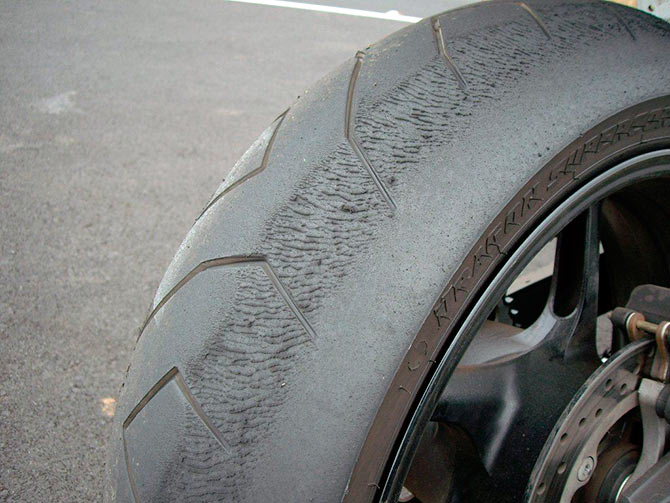For many bike riding is just a means of travel but for others, its a passion, hobby and means a lot more than many other things. They live to ride and every single mile they travel means something to them. Motorcycle tires are analogous to human legs, the healthier they are the more speed they give, the better reflexes they show. But unfortunately, many people are not familiar with how to judge the life of a motorcycle tire and when to replace them with the new ones.
Motorcycle tires have several components that worn out and losses to play their role effectively. These components can help the rider to judge how much life is left for a tire and after how much time it should be replaced with the new ones. These components are discussed one by one below:
Tire Treads

We often see a lot of grooves on the outer surface of tires. The pattern of the groove is responsible for different roles and nature of tires but what is important for the life of the motorcycle tire is its depth. Treads help in providing friction with the road as they are in contact with it and helps in displacing the water or snow that comes in contact with the tire. But as the tire starts wearing out it loses its depth and hence tire starts to skid whenever breaks are applied. As per the regulations, the tire tread depth should be anywhere between 1/32 and 2/32 of an inch to reflect a healthy status. As the maximum area of contact of a motorcycle tire with the road is in the middle of a tire so it will provide the best point to judge for the tread depth. Usually, if you drive around 12,000-15,000 miles in a year, it will take three to four years for tire tread to wear out.
Tire Sidewalls

Motorcycle tire sidewalls have a special rubber composite to add flexibility and weather resistance. Sometimes cracks can be seen on the sidewalls of the tire. These cracks are usually referred as dry rots that are normally caused by extremely high or low temperature, exposure of tire to corrosive or abrasive chemicals, exposure to direct sunlight, and underinflating (low air pressure) of the tire as it will increase the area of tire in contact with the road. Even if tire treads have depth as per regulations, dry rot on sidewalls of the tire can force you to replace them.
Aging of tire

Just like everything decays with passage of time, tires that are made of rubbers also losses their characteristics with the passage of time and the time depends on the way it gets treated. Approximate miles figure for rear and front tires are 1800 and 3700 miles respectively. But many factors play an important role in the aging of the tire. According to the National Highway Traffic Safety Administration (NHTSA) research, some factors affect the aging process of a tire which are briefly discussed below;
Temperature
The motorcycle tire aging process is faster in a warm climate as compared to cold. If a tire is exposed to direct sunlight or heat it will not only cause dry rots but also it will decrease the life of the tire.
Storage
If a tire is stored without inflation or says without a single-use it will age slower than compared to a tire that remains in service. Remember that if the tire is used once only and then never used again, it will be considered as inflated and decay faster as compared to tires that have never been inflated.
Condition of Use
This factor is a very important factor to determine the life of the motorcycle. This factor includes the air pressure of the tire, how many times it hits the curb, is motorcycle driven only on the weekend or daily basis, highways are used more often for traveling or not, how many times tire get punctured, all these factors play a vital role in the speed of the aging process.
It is usually advisable to change motorcycle tires after every five years or at least have them checked regularly and get experts’ opinions. Motorcycle tires that are manufactured after the year 2000 have a code mentioned by the manufacturer that represents the week and year in which tire is manufactured. The first two digits denote the weeks and the last two digits represent the year. For example, if a tire has code 1119 it means it was manufactured in the 11th week of the 2019 year. Hence the buyer must check this code before purchasing a new one.
Tire Bead
The tire bead is to represent the edge part of the tire that sits on the wheel and when the tire is inflated the pressure of the air keeps the bead in grooves. Hence if the air pressure of motorcycle reduces daily one should look for any tire bead damage. Usually, bead damage occurs in three ways;
Broken bead: It occurs when the tire is not properly mounted or dismounted on the rim. As the tire has not seated properly so whenever high pressure will be applied it will cause fatigue in the tire bead that will eventually lead to broken bead.
Bead chafing: It occurs when the tire is mounted on the dirty rim. Dirt has abrasive particles that when comes in contact with rubber will cause wear of tire bead.
Deformed bead: It occurs due to improper storage and also if a high load is applied on tire especially in underinflating condition. Due to high pressure applied on a single point, it will cause bending of the deformed bead.
Conclusion
The behavior of the motorcycle tire will act as an indicator for the rider to inspect the above-mentioned parts of the tire and find out the reason for it. If during the journey rider feel slippage during turns (tire tread) or have to stop more often to inflate the tires (tire bead) or feel vibrations, one should take his motorcycle for inspection of tire. Usually, it is suggested to replace tires after 5 years but with proper care and protection, the life of tire can be exceeded up to 10 years.
Also Read: How to Drift A Motorcycle



